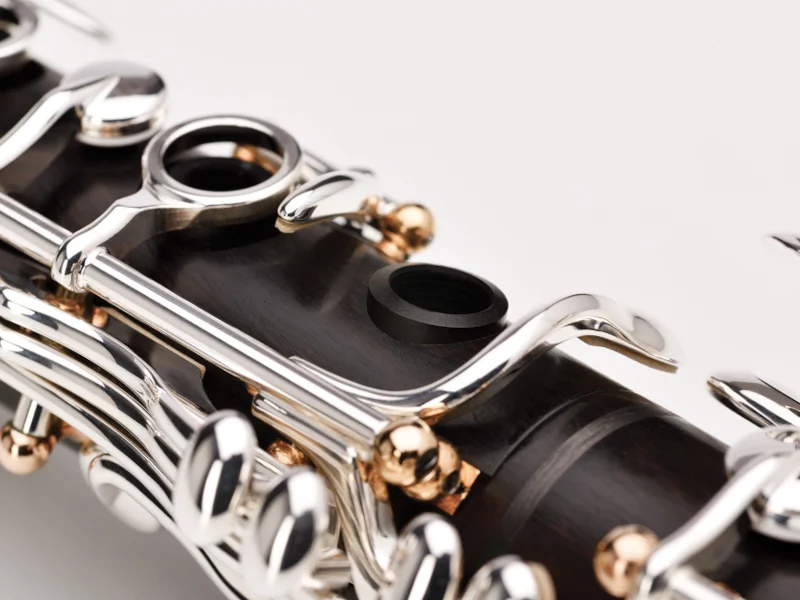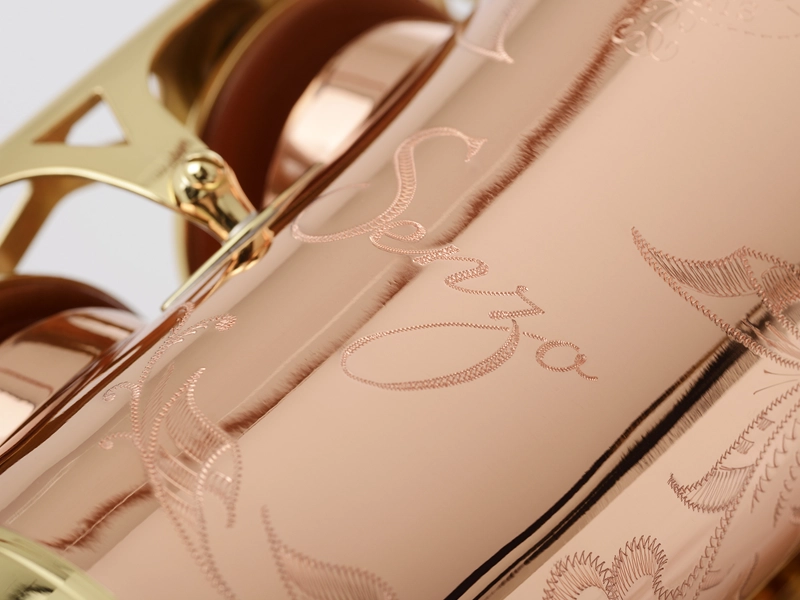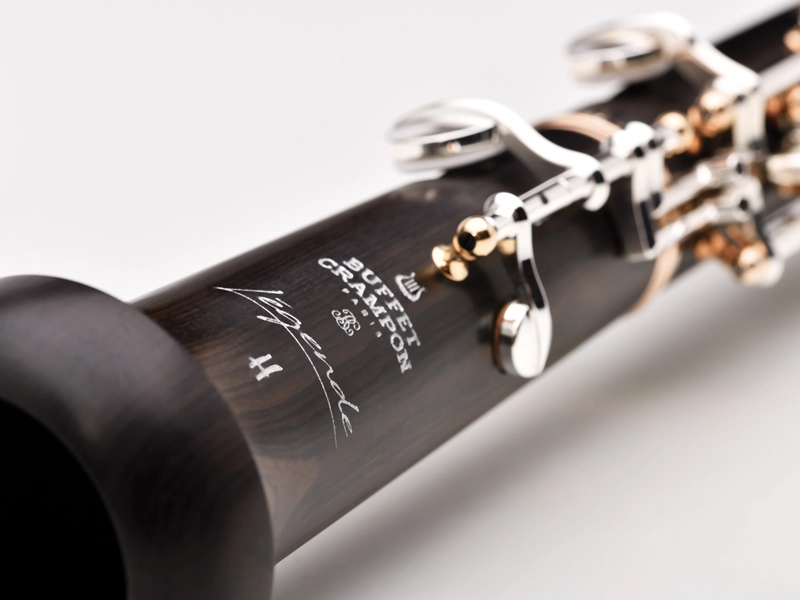维护您的乐器
单簧管
如何组装您的单簧管?
1.组装调音管和上节管
用左手握住上节管,注意不要过分用力按按键部分。在接口软木上涂上一层薄薄的 Buffet Crampon 软木膏可让安装更容易。
注:组装困难时请使用软木膏。切勿过分用力以免损坏乐器。
针对 Divine 单簧管的特别建议:
您的 Buffet Crampon Divine 单簧管配有合成接口软木。我们选择这种材料是因为其高密封性和可靠性。合成软木具有良好的弹性,这意味着合成软木在压缩后会迅速恢复到原来的形状,因此每次使用时,您的单簧管都会完美贴合。由于无需润滑接口软木,因此乐器的维护工作也变得简单。然而,如果您想润滑软木,请使用 Divine 单簧管随附的特殊合成软木润滑剂,请勿使用普通软木膏。
2.安装喇叭口和下节管
小心不要过于用力按按键。
3.安装上节管和下节管
用左手握住上节管,用右手握住下节管。调整按键的位置,使相应有联动关系的按键部分对齐
4.确保每一节上刻有商标的位置都能对齐
将笛头放在乐器上。将哨卡放在笛头上并滑动湿润的簧片。注:小心不要损坏簧片、笛头风口末端和哨卡。每次使用后盖上笛头帽,以保护笛头和哨片


如何拆卸您的单簧管?
依照以上步骤的相反顺序
单簧管保养
日常护理
1.每次使用后用随附的擦布擦拭按键
2.需使用专门为单簧管设计的专用乐器箱包。内部嵌入太紧或太松都会损坏乐器按键
3.绝对不可使用溶剂、抗氧化剂、油等(汽油、酒精、清洁剂等……)
音高
管乐器的音调高对温度变化非常敏感。通过在平均温度(20°C)的房间中演奏几分钟 Buffet Crampon 单簧管来获得稳定的音高。
音调调节
拔动二节管与上节管连接的部分:通常,乐器的音调会降低,尤其是位于上节管的音区。
拔动上节管与下节管连接的部分:通常,乐器的音调会降低,尤其是位于下节管的音区。
重要事项——避免管体开裂
1.如果是新的乐器,第一个月每天不可演奏超过 30 分钟。
2.避免温度和湿度突然变化。不要让乐器靠近热源(散热器、阳光)或置入快速流动的空气气流中。
3.将乐器放入盒子之前,请用清洁布小心擦拭。
4.无需给音孔上油用于以避免开裂。请按照上述说明操作即可。
注:如果出现了开裂,请联系授权经销商或授权售后服务站,经过认证技师的细心修理后乐器不会影响音准和音质。
使用提供的清洁布
1.演奏乐器时,请经常使用通条布。如果孔内积水,会影响乐器的性能并有损坏垫片的风险:偶尔积水的快速处理窍门:用卷烟纸擦干,卷烟纸会吸收多余的水分。
注:轻轻地将清洁刷穿过扬音管到达调音管。注意不要卡在上节管内突出的管体。
2.清洁布磨损时请更换。如果使用脏的或松散的清洁布,孔内可能会积聚残留物。
3.切勿将潮湿的清洁布与乐器一起放入盒中。清洁布中的水分可能会导致弹簧氧化生锈或按键变色。


低音单簧管
安装乐器
在软木接口上涂上一层薄薄的 Buffet Crampon 软木膏可让安装更方便。
注:如果安装有困难,请使用软木膏。切勿过分用力以免损坏乐器。
1.安装上节管和下节管。
用左手握住上节管,用右手握住下节管。将两个部件安装在一起,注意不要太用力按压按键。确保每节上刻有的商标的部分都对齐。
2.安装喇叭口和下节管。
用左手握住喇叭口,用右手握住下节管,然后组装。对于降 E 调低音单簧管,喇叭口有一个按键。握住喇叭口时,不要使其碰到下节管上的按键。
3.用螺钉将支杆牢固地固定在喇叭口上。
4.组装弯脖和上节管。
用右手握住弯脖的待组装部分,用左手握住上节管
5.将哨片放在笛头上。
将哨卡安装在笛头上并滑动湿润的哨片。然后拧紧哨卡调节螺丝。将哨片安放在笛头正确位置。注:小心不要损坏簧片、笛头末端和哨卡。每次使用后盖上笛头帽,以保护笛头和哨片。
6.安装笛头。
用左手握住乐器弯脖与笛头插接部分上部,用右手握住笛头,然后组装。


萨克斯管
如何组装您的萨克斯管?
1.始终握住萨克斯管的喇叭口或底部,不要对按键或护杆施加压力。压力太大会使其变形,从而妨碍垫片密封和乐器的正常运行。
2.确保萨克斯管弯脖和管体接口清洁、无杂物、不潮湿、无腐蚀。
3.将萨克斯弯脖管接口插入管体接口中。 注意不要向下用力过猛,否则会使吹管的弧度变形。
4.在弯脖末端的软木上涂上软木膏,以便笛头可以轻松插入,无需用力。
5.将笛头放在乐器上。将哨卡放在笛头上并滑动湿润的簧片。
注:小心不要损坏簧片、笛头末端和哨卡。每次使用后盖上笛头帽,以保护笛头和哨片。


如何拆卸您的萨克斯管?
依照以上步骤的相反顺序。
萨克斯管保养
日常护理
1.每次使用后用随附的擦布擦拭按键。
2.总是使用随萨克斯管提供的 Buffet Crampon 原配乐器箱。盒子内部太紧或太松都会损坏按键。
3.将乐器放入盒中之前,请用清洁布将音孔彻底擦干。去除水分可以保持萨克斯管内部清洁,并防止垫子粘住和过早损坏。
4.当乐器处于静止状态或存放在盒中时,请记住将笛头从弯脖上分离。这将延长软木的使用寿命,并使弯脖和笛头适当干燥。
长期保养
随着时间的推移,按键可能会卡顿或出现其他问题。建议每六个月请一位合格的技师对您的萨克斯管进行一次检查,以检查整个乐器。定期维护可以降低故障风险,避免昂贵的大修。
音调调节
1.拔出笛头:乐器的音调降低。
2.深插笛头:乐器的音调升高。
如有任何问题,请联系经销商。


Oboe
How to assemble your oboe?
1. Assemble the bell and the lower joint by gently twisting them together, taking care not to apply excessive force to the keys. To make assembly easier, apply a thin layer of Buffet Crampon cork grease to the tenon corks.
Note: Use cork grease whenever assembly is difficult. Never force the parts together to avoid damaging the instrument.
Special instructions for Légende and Légende Hybrid oboes:
Your Légende or Légende Hybrid oboe is equipped with double escapement keys on the bell. Keep the B-flat key closed during assembly and gently twist to align the connection points.
2. Assemble the lower joint/bell assembly with the upper joint, aligning the connection points while taking care not to apply too much pressure on the keys.
Special instructions for Virtuose oboes:
Your Virtuose oboe features a long upper joint. To connect the upper joint and the lower joint, keep the resonance key closed and slide the two joints together until the notch stops. Ensure that the magnetic keys connecting the crow’s foot are properly engaged.
3. Ensure that the engraved logos on each part are aligned. Then, insert your reed.


How to disassemble your oboe?
Disassemble in the reverse order.
Maintenance
Daily care
1. After each use, thoroughly dry the inside of your instrument with the provided swab. Our swabs have been specially designed to ensure optimal drying of the bore for each of our instruments. They are machine washable at 30°C in a laundry bag. A slight moisture residue may remain inside the instrument after swabbing, which is normal; a perfectly dry bore could cause premature wear of the wood.
2. Clean the keywork of the instrument with the soft cloth provided with your instrument. This cleaning ensures the long-term mechanical performance of the instrument. Be careful not to force the keys to avoid damaging the pads and key adjustments.
3. Always use the cases designed exclusively for your instrument. A case that is too tight or too loose can damage the keywork and affect the regulation of your instrument.
4. Absolutely avoid using solvent products, anti-corrosives, etc.
Tuning
The tuning of a wind instrument is very sensitive to temperature variations. Buffet Crampon oboes achieve their proper pitch when played for a few minutes in a room at average temperature (20°C).
IMPORTANT – Preventing cracks on the body
If the instrument is new, do not play it for more than 30 minutes per day during the first month.
Avoid sudden changes in temperature and humidity. Do not leave the instrument near a heat source (radiator, sunlight) or in a draft.
Before placing the instrument in its case, carefully swab the bore.
Avant de mettre l’instrument dans l’étui, passer soigneusement l’écouvillon.
Note: There is no need to oil the bore to prevent cracks. Following the above precautions is sufficient.
If a crack does appear, contact your dealer; a careful repair will not affect the intonation and sound quality.
Use of the provided swab
While playing the instrument, use the swab frequently. If water collects in the tone holes, it will affect the instrument’s performance and may damage the pads: use cigarette paper to absorb the excess moisture.
Note: Gently pass the swab from the bell through to the pip. When the swab becomes worn, replace it. If you use a dirty or fluffy swab, debris may collect in the tone holes.
Never store a wet swab in the case with the instrument. Moisture from the swab can cause oxidation of the keywork.
Long-term care
Over time, the mechanics and consumables (corks, pads, springs, screws) may become misaligned. It is recommended to have your instrument inspected annually by a certified technician to ensure the entire instrument is in good working order. Regular maintenance will reduce the risk of malfunction and prevent the need for major, costly repairs.


English horn
How to assemble your English horn?
1. Assemble the bell and the lower joint by gently twisting them together, taking care not to apply excessive force to the keys. To make assembly easier, apply a thin layer of Buffet Crampon cork grease to the tenon corks.
Note: Use cork grease whenever assembly is difficult. Never force the parts together to avoid damaging the instrument.
Special instructions for Prestige English horns with an extension:
1. First, attach the extension to the lower joint while holding the low B-flat key closed. Gently twist the parts together.
2. Assemble the lower joint/bell assembly with the upper joint, aligning the connection points while taking care not to apply too much pressure on the keys.
3. Ensure that the engraved logos on each part are aligned. Then, insert your reed.


How to disassemble your English horn?
Disassemble in the reverse order.
Maintenance
Daily care
1. After each use, thoroughly dry the inside of your instrument with the provided swab. Our swabs have been specially designed to ensure optimal drying of the bore for each of our instruments. They are machine washable at 30°C in a laundry bag. A slight moisture residue may remain inside the instrument after swabbing, which is normal; a perfectly dry bore could cause premature wear of the wood.
2. Clean the keywork of the instrument with the soft cloth provided with your instrument. This cleaning ensures the long-term mechanical performance of the instrument. Be careful not to force the keys to avoid damaging the pads and key adjustments.
3. Always use the cases designed exclusively for your instrument. A case that is too tight or too loose can damage the keywork and affect the regulation of your instrument.
4. Absolutely avoid using solvent products, anti-corrosives, etc.
Tuning
The tuning of a wind instrument is very sensitive to temperature variations. Buffet Crampon English horns achieve their proper pitch when played for a few minutes in a room at average temperature (20°C).
IMPORTANT – Preventing cracks on the body
If the instrument is new, do not play it for more than 30 minutes per day during the first month.
Avoid sudden changes in temperature and humidity. Do not leave the instrument near a heat source (radiator, sunlight) or in a draft.
Before placing the instrument in its case, carefully swab the bore.
Avant de mettre l’instrument dans l’étui, passer soigneusement l’écouvillon.
Note: There is no need to oil the bore to prevent cracks. Following the above precautions is sufficient.
If a crack does appear, contact your dealer; a careful repair will not affect the intonation and sound quality.
Use of the provided swab
While playing the instrument, use the swab frequently. If water collects in the tone holes, it will affect the instrument’s performance and may damage the pads: use cigarette paper to absorb the excess moisture.
Note: Gently pass the swab from the bell through to the pip. When the swab becomes worn, replace it. If you use a dirty or fluffy swab, debris may collect in the tone holes.
Nb : Passez doucement l’écouvillon en passant par le pavillon jusqu’à la piperelle.
Never store a wet swab in the case with the instrument. Moisture from the swab can cause oxidation of the keywork.
Long-term care
Over time, the mechanics and consumables (corks, pads, springs, screws) may become misaligned. It is recommended to have your instrument inspected annually by a certified technician to ensure the entire instrument is in good working order. Regular maintenance will reduce the risk of malfunction and prevent the need for major, costly repairs.


